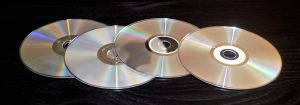
The Blu-ray Disc founder group was started in 2002 by MIT and nine leading Electronics Companies: Sony, Panasonic, Pioneer, Phillips, Thomson, LG Electronics, Hitachi, Sharp and Samsung Electronics.
The name is taken from the blue laser that is used to read from and record to a Blu ray disc, the blue laser allows for a much higher density and hence a larger storage capacity and so the Blu-Ray disc is a digital optical disc data storage format.
It was designed to supersede the DVD format, and is capable of storing several hours of video in high definition (HDTV 720p & 1080p) and Ultra High Definition Resolution (2160p).
Although the Blu-Ray disc looks exactly the same as a DVD in size and shape there are many differences between media including storage capacity,laser technology and disc construction,image resolution and player compatibility.
The Blu-Rays storage capacity is measured in gigabytes (GB), like computers and ipods.
Storage Comparison:
DVD Single Layer: Can store about 4.7GB data which is about two hours worth of movie at Standard Definition…these are commonly referred to as DVD 5’s.
DVD Dual Layer: Can store twice the amount of data at 8.7 GB which equals about four hours of movie at Standard Definition ….these are commonly referred to as DVD 9 ‘s.
Blu-Ray Single layer: Can store approximately 25Gb data, this equals about 2 hours of High Definition Information or 13 hours of Standard Definition Information.
Dual Layer Blu-Ray :can store about 50GB data which is about 4 hours of High Definition Information or 26 hours of Standard Definition.
Laser Technology
Lasers are used in both DVD and Blu-ray technology .As the disc spins the laser reads the information stored on the discs and transfers both the picture and the sound to the television.
DVD: DVD players use a red laser at 650nm wave length to read DVD discs
Blu-Ray : Blu-Ray players use a Blue laser to read the stored information; the wave lenghts are shorter than the red at 405nm and are smaller in diameter, this allows for a closer and more precise reading of the information on the disc.
Disc Construction:
Physically DVD and Blu-Ray discs are the same in appearance:both have circular tracks on their bottom layer that enables the laser to read information stored on the spinning disc.
The tracks on a DVD are much further apart than on the Blu-Ray; you will see that it follows from this that the amount of information that can be stored on each type of disc is different; the Blu-Ray having the far greater storage capacity.In short a Blu-ray can squeeze about 5 times as many tracks onto the same size disc as a DVD.
Both DVD and Blu-Ray have a protective layer designed to resist scratching; the Blu-Ray in addition has a hard coating that makes it more scratch resistant.
Image Resolution
This is measured by the number of vertical lines times the number of horizontal lines of light in a picture.It is represented by the number of horizontal lines going across the screen like 480, 720 or 1080.The higher the number, the higher the resolution the more detailed the picture you see.
DVD: Almost all DVD’s have standard definition of 480 or enhanced definition of 520.This look ok on a standard television,utilising all the available pixels on the screen. If however this is blown up to a large HDTV the picture may look grainy.
Blu-Ray: The Blu-Ray was designed for the high definition 1080 display….since they can store 25 GB data you can fit a whole High Definition movie on a single layer. Blu-Ray currently has the best image resolution on the market and looks amazing on HDTV, they are one of the only sources that display in 1080.
Player Compatibility:
Happily Blu-ray Players support DVD’s and the image will be decent but obviously not the high definition quality of a Blu-ray.
Due to the larger lasers used in DVD players they it cannot read the tiny grooves on a Blu-ray disc.
In short you can play a DVD in a Blu-ray player but you cannot play a Blu-ray in a DVD player.
Lastly and very importantly Blu-Ray can handle 4K (Ultra HD)...we don’t need an new type of disc for our new TV’s; you can have it all with the Blu-Ray !





